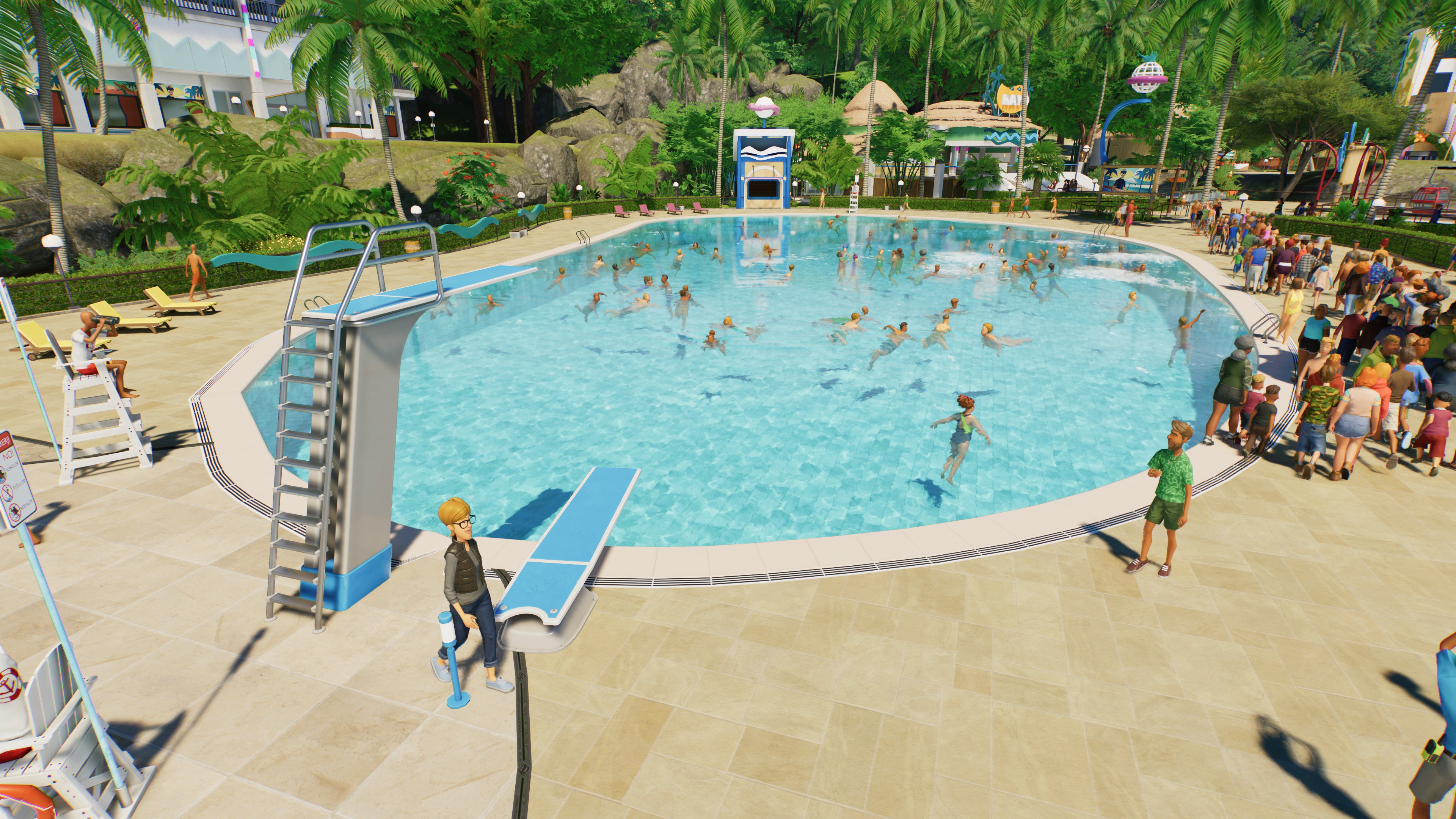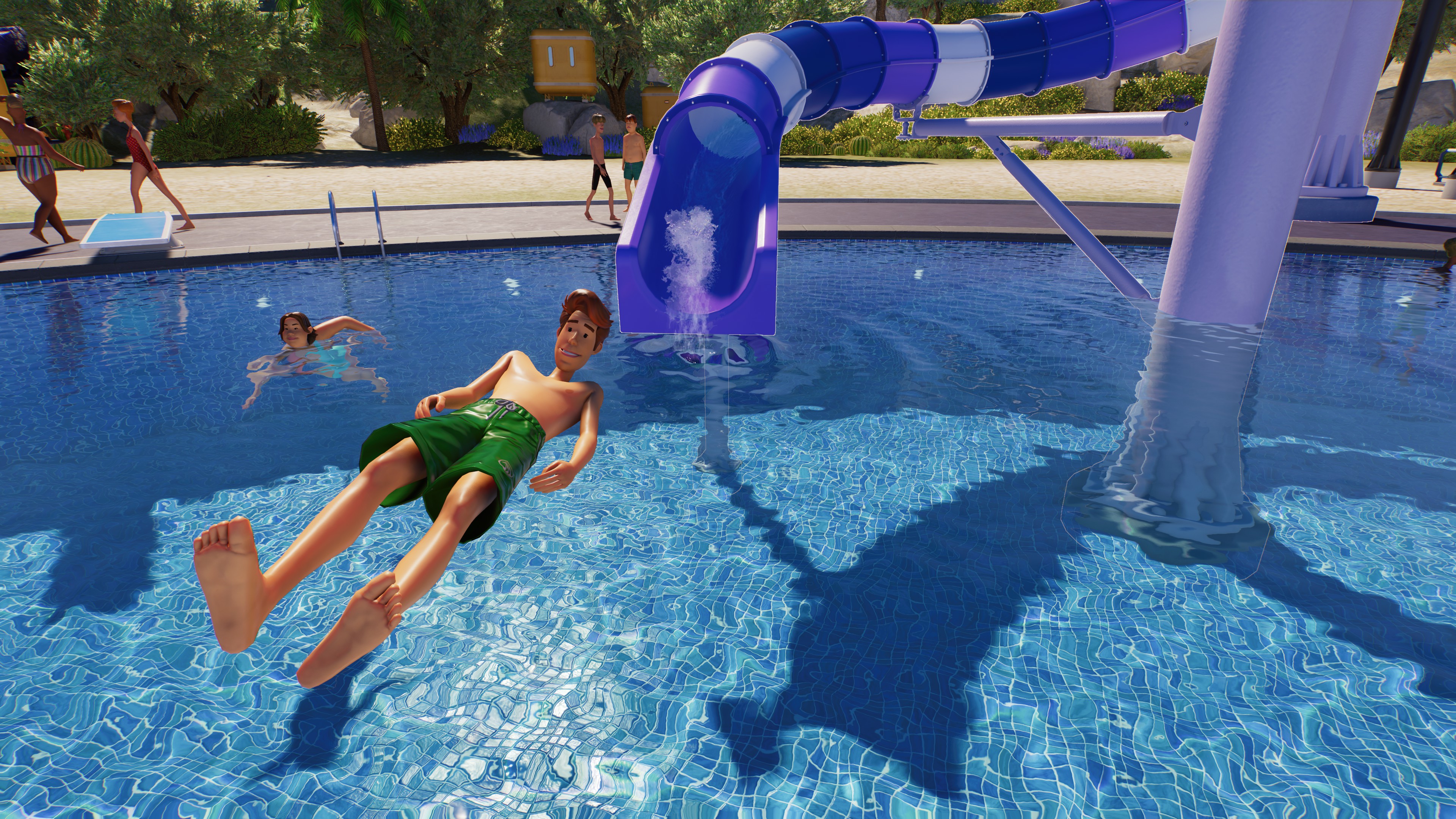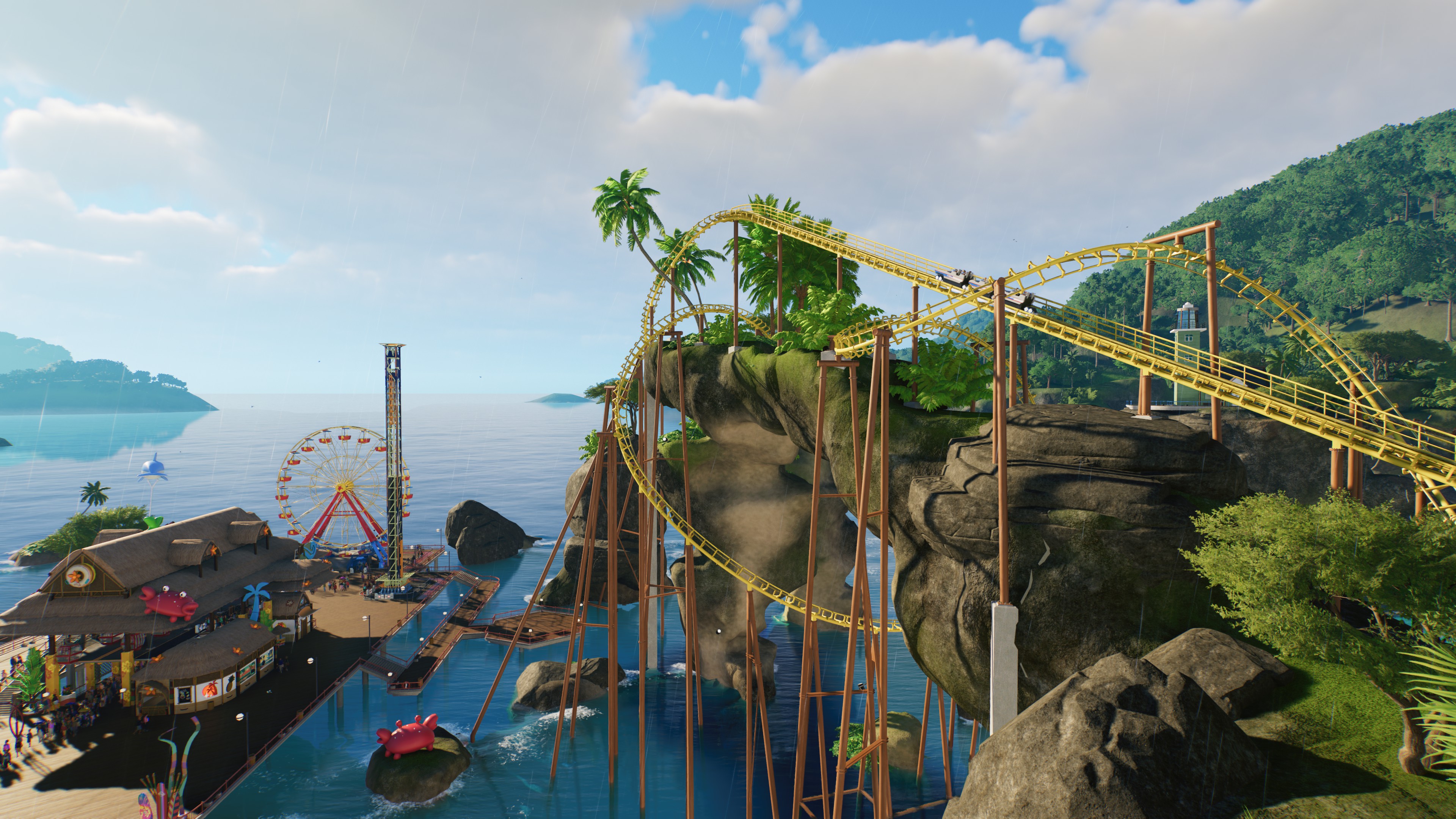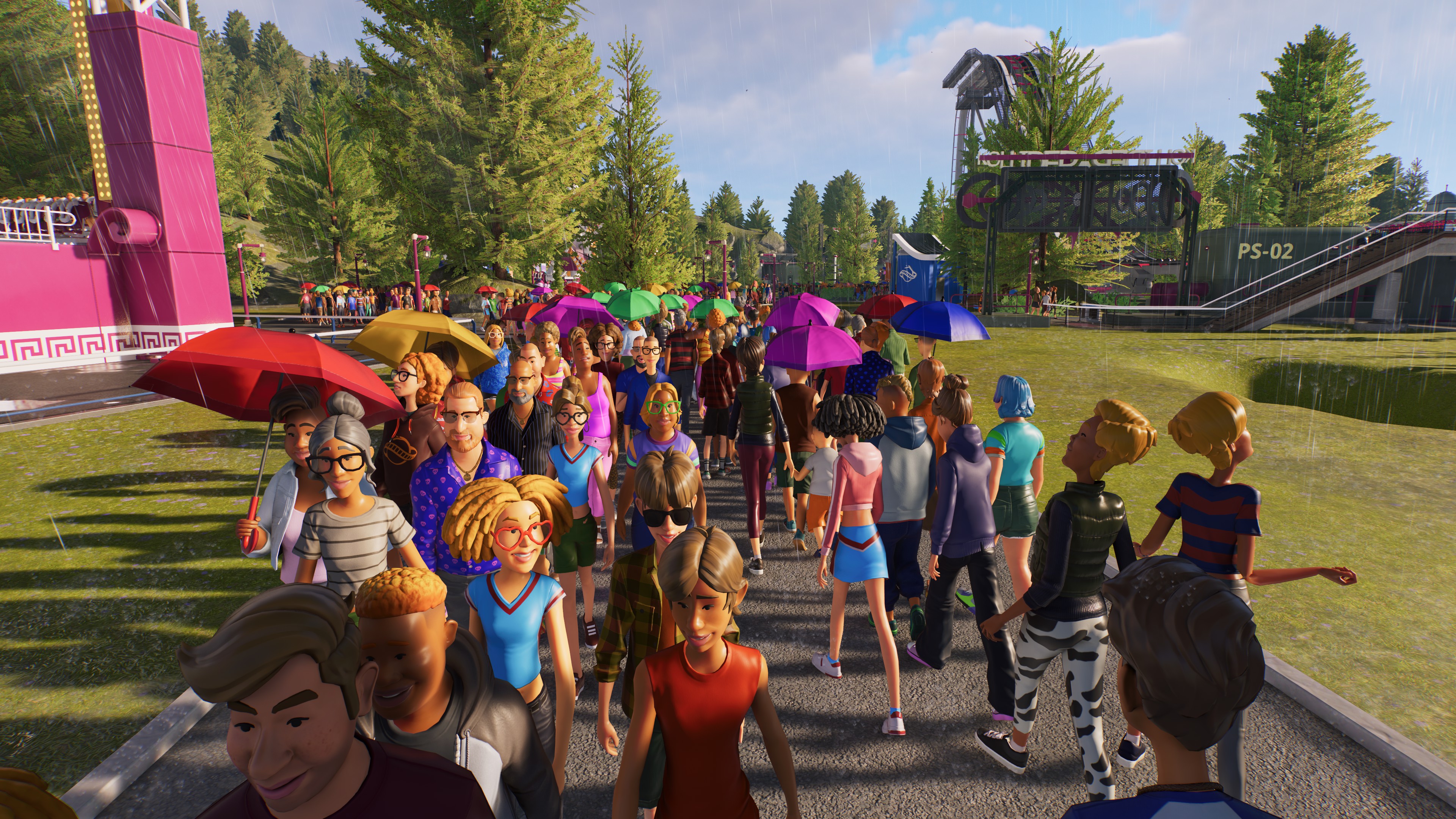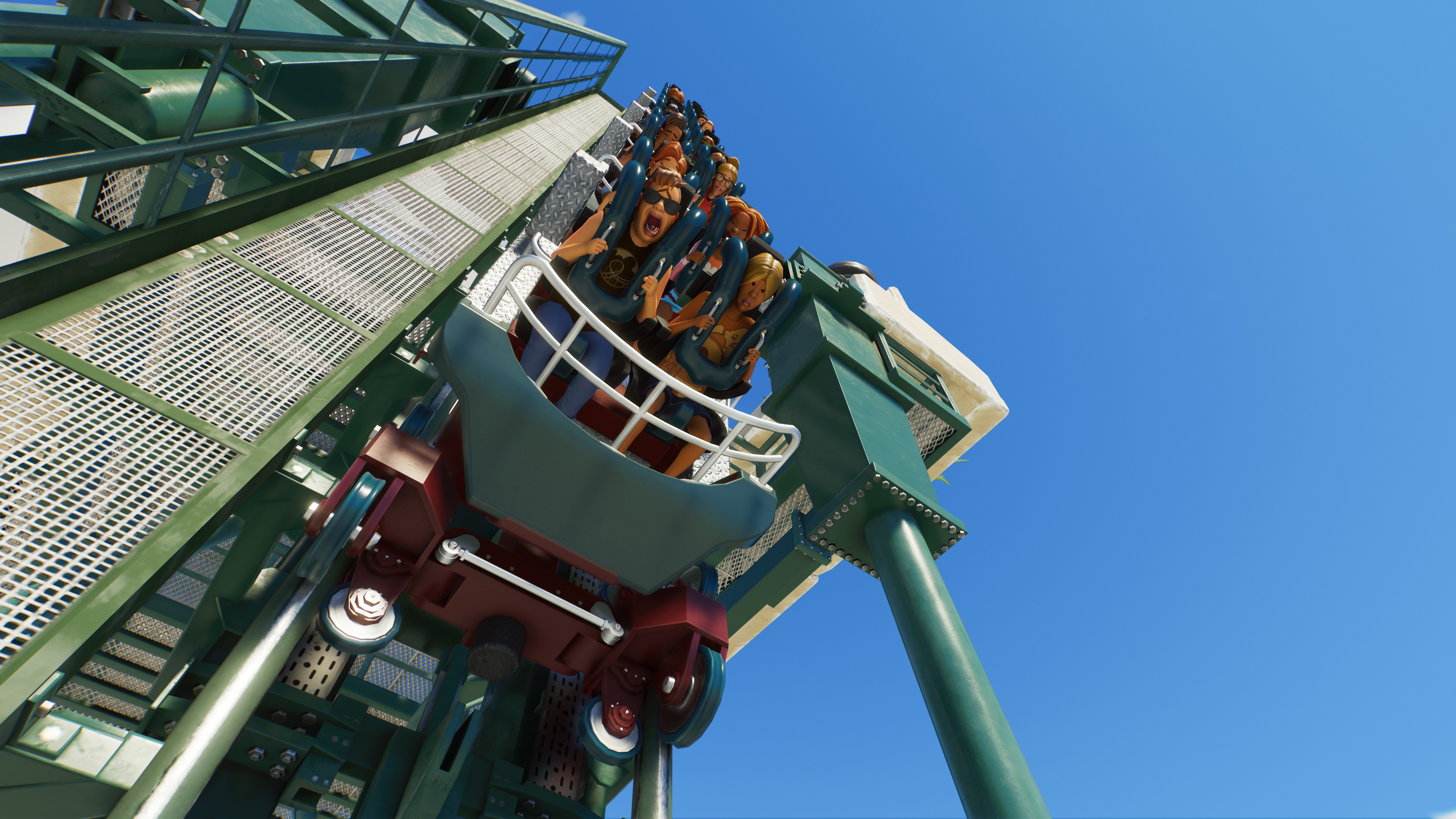Need to know
What is it? Theme park building sim with extensive customisation options and new water park features.
Release date November 6, 2024
Expect to pay £40/$50
Developer Frontier Developments
Publisher Frontier Developments
Reviewed on AMD Ryzen 5 3600, Nvidia 2080 Super, 32GB RAM, Windows 10
Steam Deck TBA
Link Official site
Back in the early noughties when I last visited Disney World, my favourite parks out of the whole archipelago of attractions were the water parks. The squealing chaos of the Typhoon Lagoon’s tsunami-generating wave pool. The terrifying, trunks-eroding descent of Blizzard Beach’s Summit Plummet. Blissfully bobbing along the lazy rivers. Oh, the lazy rivers! Forget Space Mountain or the Tower of Terror, give me a big rubber ring and let me bake my belly in the glorious Floridian sun.
Playing Planet Coaster 2 has reaffirmed my belief that pools rule, rides drool. Water attractions are the big new addition to Frontier Developments’ theme park sim, adding a new dimension to what was previously a comprehensive but unadventurous coaster creation kit. This is as well, because the sequel still coasts on its creative prowess, with actual management of its parks remaining a secondary concern.
Structurally, Planet Coaster 2 differs little from the first. You can fix and fiddle with partially built parks in career mode, or construct your own from scratch in variations upon the sandbox. These include unrestrained creativity where money and space are no object, and the more moderated Challenge mode where at least some management skills are required.
Whichever you choose, the key difference in your park building is the ability to lubricate them with water-based attractions. At the centre of these are pools. Like everything in Planet Coaster 2, you can build pools however you please using the game’s highly flexible toolset, creating everything from kidney-dish paddling pools, to aspiring lakes fringed by diving boards and wave machines.
Even when considered alone, pools are surprisingly fun additions to your park. This is largely because Frontier has gone to town on animations for pools, with shoals of visitors paddling around and treading water and splashing each other and bombing off the diving boards (naughty). There’s a freewheeling nature to the fun that contrasts with the clockwork precision of more mechanical rides, where parkgoers spend most of their time being funnelled between different queues. It lends these simulated people more personality beyond gawking, screaming, and blowing chunks.
Ultimately though, pools mainly act as a foundation for the really fun addition to Planet Coaster 2—flumes. These are various types of waterslide, ranging from straightforward downslides to zany spiralling affairs that require an inner tube to ride. Honestly, I think I may enjoy building these slippery sideshows more than actual coasters. As with your star rides, you can twist and turn the tubing of flumes to your heart’s content, creating elaborate, seemingly physics-defying designs. But they’re more compact and functionally simpler than coasters, making them far less finicky to build from scratch. You don’t have to worry about propulsion or ensuring the ride loops back perfectly on itself. Just avoid making it too nauseating and ensure visitors land in a pool rather than on jagged rocks, and you’re golden. I also just enjoy watching parkgoers fire out of the tubes like a bullet to land in a big splash, because I am a ginormous, bearded toddler.
Honestly, I think I may enjoy building these slippery sideshows more than actual coasters
This isn’t to say water attractions are completely without wrinkles. Pools require water pumps and water filters to keep them filled and clean, while you must also build changing rooms nearby so visitors can switch to their bathing gear. It’s also generally wise to recruit lifeguards to ensure visitor safety, as bathers can panic in the water and require assistance. But these elements are all easy enough to manage, and on the whole, I find pools and flumes are the most straightforwardly enjoyable part of Planet Coaster 2 relative to how difficult they are to set up.
Creative type
Although pools and flumes are the most exciting new features, it’s worth stressing that Frontier has not neglected the coaster part of Planet Coaster. Building options run the gamut from classic wooden coasters to looping steel-framed affairs; from inverted launch coasters to all new hybrid coasters that infuse water into their rides. And while there are plenty of predefined blueprints to plonk down if you’re short on time, building coasters from scratch is still the beating heart of the game. You can lose hours to tilting, tweaking, and twisting individual sections of a coaster, playing with loops and rolls, testing it over and over until it provides maximum thrills without subjecting your visitors to an astronaut’s worth of g-force.
Indeed, I think Planet Coaster 2 generally has one of the best creative toolsets out there, letting you customise pretty much any aspect of your park, right down to sticking tiny pieces of scenery onto the cars of your coasters. It isn’t always the most intuitive toolset, however. I’ll admit my coaster-building skills have atrophied in the years since playing the first game, but I’m pretty sure I didn’t have as much trouble autocompleting coasters the last time around. I also wish there was a simplified building system for slapping together scenery for items you use a lot, like shops for example. You can set blueprints for anything you build, of course, but I still find searching through and sorting the parts for these a fiddly, time-consuming process.
Regardless, as someone who blasts through character creators as quickly as humanly possible, I enjoy tinkering with Planet Coaster 2’s voluminous craft kit. Having the mechanical imperative of scenery improving your park rating helps motivate me, admittedly, but I still appreciate the power and potential in the toolset. And it’s a good thing Planet Coaster 2 is so creatively fulfilling, because as a management sim, it’s a pretty passive affair.
Management slim
This is, I reckon, partly by design. Frontier knows you’re going to be spending a lot of time building coasters and faffing with scenery, so it doesn’t want you fighting fires constantly. But it’s also because Planet Coaster 2’s simulation is extremely friction averse. Unlike the Two Point games, where poor management results in failing students or dead patients, the worst that can happen in Planet Coaster 2 is that your visitors barf or have a bit of a thrash in the pool. I’m not saying Planet Coaster 2 should feature drowning children or horrific ride disasters, more that it rarely throws any real curveballs your way. Too many rides breaking down? Hire more mechanics. Too much litter? Place more bins and hire more janitors. Even financial management is more about how quickly you make money rather than avoiding losing it.
Perhaps this is why, contrary to my expectations, I ended up drawn more to the career mode than the sandboxes this time around, because it’s better at laying down challenges that play to the series’ strengths. Assuming the role of a new manager for theme park conglomerate Coaster Coast, the career mode sees you tasked with building or overhauling a network of theme parks across the globe. By completing the predetermined objectives, you earn stars that accrue to unlock later career chapters.
I ended up drawn more to the career mode than the sandboxes this time around
In and of themselves, the objectives are not especially original, at their most basic asking you to “hire three janitors” or “place four flat rides”. What makes them interesting is the context in which you must often achieve them. One level, for example, sees you building a park on two lofty clifftops separated by a precipitous gorge. This makes an objective like “Build a coaster with a minimum 45 metre drop” a lot more intellectually stimulating than if you were just building on a sandbox plain with zero restrictions. Likewise, dealing with the limited space of the clifftop makes “Build a coaster at least 600 metres in length” far more of a puzzle than it would be in sandbox mode.
This balance of structure and freeform play also applies to the campaign more broadly. The star system is pretty generous in terms of what other parks it lets you unlock, so you don’t have to perfect one park to try the others. Hopping between parks tackling different challenges as you see fit chimes with the tinkerer’s heart of Planet Coaster 2, and I enjoyed sampling its extensive buffet of ideas.
To be clear, this isn’t to say the other two modes aren’t worth your time. Creative mode is perfect for players who just want to build the biggest, most elaborate park possible with no constraints, while Challenge Mode gives you overall control while requiring you to keep your park financially fluid. There are also a few issues with the career mode. The narrative framing, which has a variety of characters advising you on park building, is pleasant enough, but is witless and anodyne compared to the satirical flourishes of the Two Point games. Moreover, the pathing tool, which always has the potential to be a fussy little beggar, is especially uncooperative in career mode where there is a lot of bespoke geometry.
There are richer management sims out there than Planet Coaster 2, and if you want a game about spinning plates and sticking more than a few of them back together, I’d sooner recommend either of the Two Point games or, for the ultimate organisational challenge, Factorio and its Space Age expansion. That said, nowhere is the act of building a theme park better represented than in Frontier’s series, and the sequel’s added water attractions unquestionably elevate it above the original. Most importantly of all, it lets you build lazy rivers. Avert your eyes, folks, the belly’s coming out.


